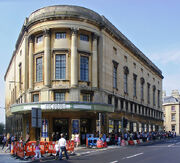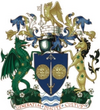Bath, officially the Royal City of Bath, is the capital city of the United Kingdom of Wessex and Cornwall. It is situated 13 miles (21 km) south-east of Bristol in the county of Somerset and the Borough of Bath. The population, as of 2013, is 83,992.
The city was first established as a spa with the Latin name, Aquae Sulis ("the waters of Sulis") by the Romans sometime in the AD 60s about 20 years after they had arrived in Britain, although oral tradition suggests that Bath was known before then. They built baths and a temple on the surrounding hills of Bath in the valley of the River Avon around hot springs. Later, Bath became a Spa town, in the Georgian Era, which led to a major expansion that left a heritage of exemplary Georgian architecture crafted from Bath Stone.
Much of Bath is a World Heritage Site, and has been since 1982. Bath became the capital city of Wessex in 1972, and later the United Kingdom of Wessex and Cornwall in 1985. The city has a variety of theatres, museums, and other cultural and sporting venues, which have helped to make it a major centre for tourism, with over one million staying visitors and 3.8 million day visitors to the city each year. Aswell as being a cultural, centre, Bath is also known for its education, with two Universities, two Sixth Forms, and several State and Private Schools, msot notably, Bath University, Bath Spa University, and the Royal Secondary School.
Governance[]
Economy[]

The Southgate Shopping Centre and Bath Skyline
While Bath is not really the a centre for Wessex and Cornish economy like Bristol, it mostly revolves around Politics, Education and Tourism. Tourism is popular around the year, with over 3.8 Million visitors per year. Bath is however, the headquarters of several major companies, however far less than other cities in the country. Major companies include Future Publishing, Wessex Water, and several Mortgage Brokers and Small Banks. Bath has historically been a centre for banking, and today still has a major financial presence.
Tourism[]
One of Bath's principal industries is tourism, with more than one million staying visitors and 3.8 million day visitors to the city on an annual basis. The visits mainly fall into the categories of heritage tourism and cultural tourism, aided by the city's selection in 1987 as a UNESCO World Heritage Site. All significant stages of the history of England are represented within the city, from the Roman Baths, to Bath Abbey and the Royal Crescent, to Thermae Bath Spa in the 2000s. There are a total of 80 hotels and 180 bed and breakfasts in the area.
Some of the most visited attractions include Bath Abbey, the National Museum, the Roman Baths, Thermae Bath Spa, and Southgate Centre.
 The View from Bath's modern spa, Thermae.
The View from Bath's modern spa, Thermae.
Geography[]
Notable Landmark Buildings[]
- Bath Cathedral:
- Bath Guildhall: Bath Guildhall is the headquarters of the Ministry of the Treasury, and the Ministry of Finance. The Guildhall was built in 1775, by Thomas Baldwin.
- National Archives: The National Archives is located on Johnstone Street, adjacent to the National Gardens, and the Palace of Justice. The National Archives was built in 1974, along with the other two modern Georgian style buildings in the area.
- National Gallery and Museum: The National Gallery and Museum (NG&M) was completed in 1976, and built alongside the Palace of Justice on Pantheon Road. Built in the typical Georgian Style, the NG&M is the most visited museum in Wessex and Cornwall.
- Palace of Justice: The Palace of Justice is the location of the Supreme Court of Wessex and Cornwall, and the national Ministry of Justice located on Pantheon Road across from the National Gardens. The building was completed in 1975, and built in the traditional Georgian style, to blend in with existing architecture. The Palace of Justice was opened by King Edward in 1976.
- Palace of Victoria (Houses of Parliament): The Palace of Victoria is the meeting place of both houses of the Parliament of Wessex and Cornwall. Built in 1851, to house the Royal Bath School, which closed in 1902. The building was later refurbished to house the Parliament chambers. The Palace of Victoria is named after Royal Victoria Park, of which it is situated in.
- Pulteney Bridge:
- Roman Baths: The Roman Baths is arguably Bath's biggest tourist attraction. The Roman Baths date back from the AD 60's, and the time of Bath as Georgian Spa Town. The Baths are open to public, located in Central Bath across from the Cathedral. The Baths lie on top of the anomalous hot springs.
- Rosewarne House: Rosewarne House, also referred to as the Royal Residence, is the official residence of the Reigning Monarch of Wessex and Cornwall. Named after the Royal Family, the House of Rosewarne, the building was formerly Sydney House, and Holbourne Art Museum, until 1972 when it became the Royal Residence. The house is located at the end of Great Pulteney Street, also known as the Royal Parade, and backs onto the public Royal Gardens.
Notable Monuments and Memorials[]
- King Edward Statue: The King Edward Statue is located in the National Gardens, it commemorates th first Monarch of Wessex and Cornwall, who died in 1981.
- National Memorial: The National Memorial, also known simply as 'The Obelisk' is the largest memorial in Bath. It commemorates the nation, and the Obeslisk represents how the country stands out from others. The memorial is surrounded by other statues, in a small arboretum.
- National Police Memorial: The National Police Memorial, also known as 'The Beat Memorial' commemorates those who have died on police duty. The memorial is housed within the arboretum of the Obelisk. We will remember, today, tomorrow, forever is enscribed on the memorial.
- National Firefighters Memorial: The National Firefighters Memorial is housed within the arboretum, and commemorates those who have fallen whilst tackling fires.
- Pantheon of Wessex: The Pantheon of Wessex is a small domed rotunda located in Victoria Park, constructed in 1855. The 'Pantheon' commemorates the most influential, and most important rulers of the Kingdom of Wessex in the 6th and 10th centuries, including Cerdic, Cynric, Alfred the Great, Athelstan and Egbert.
- Statue of Alfred the Great: The Statue of Alexander the Great is located within the National Memorial Arboretum, commemorating his protection of the ancient Kingdom of Wessex from Viking Conquest, and the King of Wessex from 871 to 899.
Gardens and Parks[]
- National Gardens: The National Gardens are situated between the National Gallery and the Palace of Justice, on Johnstone Street, and Pantheon Road. The National Gardens hold several memorials, including the National Memorial and its arboretum containing, the National Police Memorial and the National Firefighters Memorial. The King Edward Memorial is also situated in the gardens.
- Parade Gardens:
- Royal Gardens:
- Royal Victoria Park:
Culture[]
Architecture[]
There are many Roman Archeological Sites in and around Bath, but the Baths themselves, are now located 6 metres below the city's modern street level. Bath is most famous for its array of Georgian Architecture, which can be seen across the city. Many Houses in the city are of Georgian Origin, particularly those in the Crescents which are numerous across th city.

The Forum Theatre
Arts[]
Bath is a major centre for Arts, including Theatre, Music, and Visual Arts. Avalon Records has its main recording studio in the city. Bath is also notable for the award winning Forum Theatre, which has had many award-winning performances over the years.
TheNational Museum of Wessex and Cornwall also has a major collection of Art, and holds regular Exhibitions from both Local and International Artists.
Infrastructure[]
Education[]

Bath University Campus
Bath has two major univeristies, The University of Bath, and Bath Spa Univeristy. Bath University was named University of the Year by the Sunday Times (2011) and is known, academically, for the physical sciences, engineering, mathematics, architecture, management and technology. Bath is also famous for its large Private Schools, such as the Royal Senior School, and Kingswood School.
Healthcare[]
Transport[]

Bath's Central Bus Station
Bath is 13 miles to the south-east of the largest city of Wessex and Cornwall, Bristol, linked by the major A4 road. Bath's transport network is dominated by the First Group, with both Bus, and Rail links to the city. Bath's train station, Bath Spa Station, is linked to mcuh of the country by the Great Western Line, and the Bristol Metro which links the city to central Bristol Temple Meads Station on the Capital Line. Bath's nearest airport is Bristol Airport, approximatley 20 miles west of the city.
Twinning[]
- Aix-en-Provence, France
- Amsterdam, Netherlands
- Budapest, Hungary
- London, United Kingdom
- Tokyo, Japan













